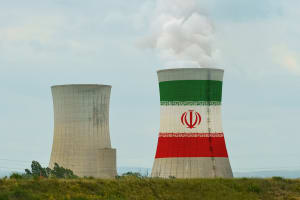Gaza under Islam: 1,300 years of caliphates, crusades and conquests
The history of Gaza – part 3 of 4

The city of Gaza is mentioned in the Bible as early as Genesis 10, just after the flood. Although not central, it is mentioned a number of times throughout the Bible, and it has been ruled by an incredibly huge variety of kingdoms, both ancient and modern.
These include ancient Egypt and modern Egypt; ancient Philistine and modern Palestine; ancient Israel and modern Israel; ancient Greece, and crusader kingdoms; ancient Rome, and modern British Empire; ancient Ottoman Empire and involvement by modern Turkey, as well as historic Islamic caliphates and contemporary attempts to revive them.
Gaza has been sacked by Mongols, and destroyed by plagues and wars. It was the site of the first suicide attack in history, and it was inhabited or visited by people as diverse as Samson and Delilah, St. Porphyrius, Rabbi Israel Najara, the false Messiah Shabtai Zvi, Napoleon Bonaparte, and it’s the burial site of the prophet Muhammad’s great-grandfather.
Just imagine what an amazing place it would be to visit if it weren’t a perpetual war zone.
No one really knows where the name “Gaza” comes from. Maybe it had a meaning in an ancient forgotten Anakite or Canaanite dialect. The initial sound is not actually a 'G' – it’s a guttural 'R'-sound, common in Semitic languages, often transcribed as 'Gh' in European languages.
The European transcription “Gaza” was already used by the ancient Greeks. In Modern Hebrew, this sound fell away, which is why Gaza is called “Azza” in Hebrew. There’s a theory that the name comes from a Canaanite word for “strength,” but since the ancient word for strength doesn’t use that 'Gh' sound at all, it’s probably not true.
In the last article, we left off with Gaza in the 6th century as a center of Byzantine and Christian philosophy in Late Antiquity, housing a famous rhetorical school and a library. There was also a large Jewish community and a synagogue with an amazing mosaic. But then, in 634 A.D., the Muslim army arrived. After their victory in the Battle of Ajnadayn near Beit Guvrin, the countryside belonged to them, but cities like Gaza were still fortified. Gaza fell after three years of siege in which the Byzantine Christians and Jews fought, side by side, against the invading Muslim army. When the city fell in 637 A.D., the Muslims didn’t destroy the city, as they knew it was the burial place of Muhammad’s great-grandfather.
We don’t know how quickly the Islamization went, but we do know that the local Samaritans fled and that the Christians were reduced to a minority. The common language became Arabic, and many churches were changed into mosques. For example, the “Great Mosque of Gaza,” which is still known as the biggest and oldest mosque in Gaza, was originally the Cathedral of John the Baptist. The Jews and Christians were not persecuted however, but allowed to live under the “dhimmi” status and pay the “jizya” tax.
Gaza came under the Rashidun caliphate, and later fell under the subsequent Damascus-based Umayyad Caliphate from 661 A.D., and later the Baghdad-based Abbasid Caliphate from 750 A.D. While Gaza continued to be an important trading point, connecting the Mediterranean ships to the caravans of the desert, there was a diminishing export of wine and olives, and a general decline in prosperity. Gaza became a center of writing of Islamic Law in the 8th century, and there is also preserved correspondence between Egyptian and Gazan rabbis from the early 9th century.
The end of the first millennium brought wars and problems. In 909 A.D., the Abbasids lost North Africa to the Fatimid Dynasty, and from 977 A.D., the Fatimids also ruled Gaza, while the rest of Palestine was under the Seljuk Turks. There are indications that the Jews might have been expelled from Gaza around this time, or that the Jews living in the countryside around Gaza were forced to move into the city. The historical evidence is not conclusive.
In 1077, Gaza was captured by the Turks and was completely sacked again, and then in 1100 A.D., the European crusaders arrived – and they found Gaza uninhabitable and in ruins. King Baldwin III built a small castle there in 1149 and granted the city and its surroundings to the Knights Templar. The Great Mosque of Gaza was turned back into a cathedral, and slowly, people began to move there again, building houses around and outside the castle. In 1177, Salah el-Din (Saladin) attacked Gaza and killed all inhabitants, but could not capture the Crusader castle. In 1187, the crusaders surrendered Gaza to Saladin’s forces in a hostage deal, and a few years later, Saladin made sure to wreck the fortifications of Gaza.
In 1192, Richard Lionheart captured the city and rebuilt the walls, but then had to demolish them a year later in a treaty agreement with Saladin.
Saladin established the Ayyubid Dynasty, which ruled Gaza until the Mongol invasion in 1260. The Mongols completely destroyed Gaza but didn’t continue to Egypt, and eventually, the Mamluks from Egypt took control. The Mamluks were non-Arab Muslims, mostly Turkic peoples, who started as freed slave-soldiers who took control over their former masters.
There are traveling Jews passing through the land of Israel in the 12th and 13th centuries, some even journeying through Gaza, but no one mentions any Gazan Jews. This changed with the Mamluks. A thriving Jewish community emerged, and traveling Jews and Christians in the 14th and 15th centuries spoke about Jewish neighborhoods and wine production in the city. In 1481, a traveler said that Gaza had 70 Jewish and four Samaritan families, and they lived in the “Yehudika” – the Jewish quarter. As Gaza thrived, the Mamluks developed the city with a horse-race course, an Islamic school (madrasa), mosques, a khan, a hospital, and a castle.
But there were also a lot of troubles under the Mamluks, not all their fault. There was a devastating earthquake in 1294, ongoing Mongol attacks in 1299, a bubonic plague in 1348, a destructive flood in 1352, swarms of locusts destroying their crops in 1401, and ongoing civil wars and squabbles between local Mamluk leaders throughout the centuries in which they ruled. When the Ottoman Turks arrived in 1516 with a quick and effective army, that was the end of the Mamluk era.
The Ottomans would go on to rule all the Middle East and southeastern Europe for several centuries until World War I. When they occupied Gaza in 1516, it was a small town with an inactive port, but as always, its strategic location along the trade route – and the way it functioned as a gateway to Mecca and Medina – made the new rulers realize that this place had potential. And this is when the Ridwan Dynasty emerged.
The Ottomans relied on loyal local rulers for administration, and the Ridwan Dynasty rose to prominence, ruling the sanjak of Gaza, which stretched from Jaffa to Gaza along the coast, and as far inland as Beit Guvrin. The Ridwans managed tax collection, security and the local governance for the first two thriving centuries of Ottoman rule. They maintained order and managed the flow of pilgrims and trade.
During the Ridwan era, the Christians and Jews of Gaza also thrived. Most Christians from Shoubak, in modern-day Jordan, emigrated to Gaza in the early 16th century to seek better economic opportunities.
Their arrival added to the cultural richness of the city and contributed to Gaza’s prosperity, bringing with them knowledge and skills in trade and agriculture. Ottoman tax records from this era also register 95 Jewish families living within Gaza.
In the 17th century, Jewish life in Gaza developed a lot under the kabbalist and poet, Rabbi Israel Najara (1555-1625). Soon after, in the 1660s, Gaza became a center for kabbalah and mysticism under Rabbi Nathan of Gaza (1643-1680). Rabbi Nathan was not just a regular kabbalist; he claimed to be a prophet and asserted that he could see supernatural visions. When the false Jewish Messiah, Shabtai Zvi (1626-1676), arrived in Gaza in 1665, Rabbi Nathan declared him as the Messiah, claimed that he was, himself, the Elijah of this Messiah, and that the Messianic Age would begin in 1666, when the Jews would conquer the world without bloodshed, and the Messiah would lead the 10 lost tribes back to Israel.
Shabtai Zvi, a native of Smyrna, taught that in the Messianic age, actions traditionally viewed as sinful would be redefined as righteous. As a result, he deliberately violated Jewish commandments as part of his belief system. His movement shook the entire Jewish world, from the Netherlands to India, as a growing number of prominent rabbis became his followers.
When the rabbis of Jerusalem excommunicated this entire movement, Rabbi Nathan proclaimed Gaza as the new holy city for Judaism and traveled to spread this gospel among Jewish communities from Europe to India. But when the Sultan imprisoned Shabtai Zvi and forced him to choose between death and Islam, he chose Islam. This led to an abrupt end of the movement, which became a laughingstock for many Jews, Christians, and Muslims throughout the world. Nathan didn’t give up, however. He claimed that this was all a part of the big Messianic scheme, however, he was forced to leave Gaza and live the rest of his life fleeing and trying to spread his “gospel,” moving from city to city throughout modern-day Turkey, Greece and Italy until his death.
In this era of the 1660s, Gaza was sometimes called “the capital of Palestine” due to how strong and prosperous the Ridwan clan made it. The markets grew, more mosques were built, and Turkish baths were established. But they were also accused of “pro-Christian tendencies” and a failure to properly protect the Muslim pilgrims on their way to Mecca.
From the 1670s, they attempted to be more anti-French and anti-Christian to appease the Ottoman rulers. The Jewish community of Gaza stayed strong despite this, and in 1674 and 1726, visitors to the city attested that the Jews comprised a quarter of the city’s inhabitants, and that they were engaged in trade and translation services.
But in the 18th century, Gaza’s golden age came to an end, as the Ottomans established more direct control of the city and deposed the Ridwans. Gaza became the center of an anti-Ottoman revolt in 1763, and then a French general named Napoleon arrived from Egypt in 1799. He quickly conquered Gaza, which he called “the outpost of Africa, the door to Asia.”
Napoleon continued along the coast, planning to conquer all of Israel and establish it as a Jewish homeland, effectively making him the first secular Zionist before the term was even coined. But when he failed to conquer Acre in the north, he returned to Egypt and abandoned Gaza. Eventually, he went home to France and became emperor instead, and conquered less complicated places. Like all of Europe, for example.
Napoleon just went and left, but most inhabitants – including most Jews – fled, especially as a plague hit the city at the same time. In the 1800s, Gaza was small, and its harbor had once again fallen into disuse for an extended period. During most of this century, it was under the rule or influence of the Egyptian part of the Ottoman Empire. Muhammad Ali of Egypt had his own army and actively fought the Ottomans for increased autonomy, and conquered Gaza and most of Palestine in 1832, but then he lost the battle of Gaza against the Ottomans in 1840. This hit Gaza even more, especially as they had just had another bubonic plague in 1839.
During the second half of the century, things shaped up a bit. Mosques and churches were restored, a more modern municipal council was established, and Jews slowly returned, establishing a new core of Jewish life in the city, including a few families arriving in the 1880s of the first Zionist Aliyah – immigration wave – to Israel. By 1895, sources speak of 12 Jewish families in Gaza.
The early 1900s saw the construction of the Hejaz railway, from Damascus to Medina through modern-day Jordan, bypassing Gaza and redirecting some of the movement of people who had previously gone through Gaza. The port remained an important trading port however, as its strategic location and fertile soil continued to make Gaza an important city. Rabbi Nissim Ohana came to the city in 1907 and established a yeshiva, a mikveh and a Jewish cemetery, and Jewish life in the city began to accelerate again. The Jews of Gaza acquired a trade monopoly on exporting watermelons, through the port of Gaza to Hamburg, which were grown by Bedouins in the Negev Desert. Ironically, this means that if you had said “watermelon” and “Gaza” to a person living back then, they would have immediately associated it with Jews.
Then World War I broke out, and in 1916, the Ottomans expelled all Jews from Gaza in preparation for an impending confrontation. The British were coming.
The final installment in the series, Part 4, will explore Gaza’s modern history, spanning from 1917 through Oct. 7, 2023.
Click to read about the biblical history of Gaza, Part 1 and Part 2.

Tuvia is a Jewish history nerd who lives in Jerusalem and believes in Jesus. He writes articles and stories about Jewish and Christian history. His website is www.tuviapollack.com














